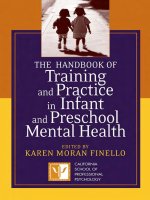the handbook of competency mapping
Bạn đang xem bản rút gọn của tài liệu. Xem và tải ngay bản đầy đủ của tài liệu tại đây (1.32 MB, 251 trang )
The Handbook
of
Competency Mapping
The Handbook
of
Competency Mapping
Understanding, Designing and
Implementing Competency
Models in Organizations
Second Edition
Seema Sanghi
Copyright © Seema Sanghi, 2007
All rights reserved. No part of this book may be reproduced or utilized in any
form or by any means, electronic or mechanical, including photocopying,
recording or by any information storage or retrieval system, without permission
in writing from the publisher.
First published in 2007 by
Response Books
Business books from SAGE
B 1/I1, Mohan Cooperative Industrial Area
Mathura Road
New Delhi 110 044
Sage Publications Inc
2455 Teller Road
Thousand Oaks, California 91320
Sage Publications Ltd
1 Oliver’s Yard, 55 City Road
London EC1Y 1SP
Sage Publications Asia-Pacific Pte Ltd
33 Pekin Street
#02-01 Far East Square
Singapore 048763
Published by Vivek Mehra for Sage Publications India Pvt Ltd, typeset in
10.5/12.6 pt CG Times by Innovative Processors, New Delhi, and printed at
Chaman Enterprises, New Delhi.
Library of Congress Cataloging-in-Publication Data
Sanghi, Seema, 1961–
The handbook of competency mapping: understanding, designing and
implementing competency models in organizations/Seema Sanghi.—
2nd ed.
p. cm.
Includes bibliographical references and index.
1. Core competencies. 2. Organizational effectiveness. 3. Strategic planning.
4. Management. 5. Employees—Training of. I. Title.
HD30.28.S266 658.4’012—dc22 2007 2007040868
ISBN: 978-0-7619-3598-8 (Pb) 978-81-7829-761-3 (India-Pb)
The Sage Team: Leela Kirloskar, Koel Mishra, and Rajib Chatterjee
To,
Pradeep, Prateek and Sakshi
Contents
List of Tables xiii
List of Figures xv
List of Boxes xvii
Preface xix
Acknowledgements xxi
PART ONE
Chapter One: Introduction to Competency 3
What is Competency? 8
Competencies for Competitive Advantage 13
Myths about Competency 15
A Quick Glance at the History of Competency 18
Chapter Two: Developing Competency Models 20
Hiring the Best Available People 25
Productivity
Maximization 26
Enhancing the 360-degree Feedback
Process 26
Adapting to Change 26
Aligning Behaviour
with Organizational Strategies and Values 27
Various Models 28
Development of the Personal Competency Framework 29
The Personal Competency Framework 29
The Lancaster
Model of Managerial Competencies 31
Level One 33
Level Two 33
Level Three 34
Transcultural Managerial Competencies 35
Personal Competency Framework—Maruti Udyog Ltd 36
Planning to Develop a Competency Model 37
viii The Handbook of Competency Mapping
Chapter Three: Issues Related to Developing
Competency Models 42
Is the Organization Serious about it? 42
What is the Goal—Quality or Excellence? 43
Is the Development Effort Periodic or Continuous? 44
Is the Assessment a Continuous Process or is it
a One-time Endeavour? 44
Are the Competencies Reflecting Current Activities
or Future Activities? 45
What should be the Time Frame for the Project? 45
How will the Organization Use the Results? 46
What is the Value Addition for the Organization? 47
What is the Value Addition for Employees? 47
How will the Determinants of Success be Measured? 48
What are the Desired Outcomes? 48
Who is the Owner of the Process? 49
Who All will be Targeted? 49
Who All will be Involved in Development? 50
Who will be Assessed and by Whom? 50
How to Validate the Assessments? 53
How will the Competency Project be Communicated
to the Employees? 54
Chapter Four: Competency-based Application 55
Position Requirement 57
HR Competence Audit 58
Analysis 61
Position Fulfilment 61
Performance Management 64
Promotion 71
Competency Models Can Enhance HRM Systems 71
Benefits of Using a Competency-based Selection System 75
Benefits of Using a Competency-based Training and
Development System 78
Benefits of a Competency-based
Performance Appraisal System 79
Benefits of Using
a Competency-based Succession Planning System 80
Chapter Five: Formation of a Competency
Framework 82
Sources of Competency Information 82
Contents ix
Position Documentation 85
Process Documentation 87
Existing Documentation 90
Personnel Development Resources 91
Interviews 92
Behavioural Event Interview 93
Behavioural Description Interview (BDI) 95
Behavioural Event Interviewing Methodology 96
Teams 101
Benchmarking 102
Established Models 104
Management Directed 104
Third-party Models 105
Case in Point—One 109
Template 1: Organization Chart—Functional Heads 110
Template 2: Sequence of Operation for Production of XYZ 111
Template 3: Quality Management System—General
Requirements 112
Template 4: Quality Management System—Documentation
Requirements 112
Template 5: Quality Management System—Quality Manual 113
Template 6: Quality Management System—Control
of Documents 113
Template 7: Quality Management System—Control
of Records 114
Template 8: Management Responsibility—Management
Commitment 114
Template 9: Management Responsibility—Customer Focus 115
Template 10: Management Responsibility—Quality Objectives 115
Template 11: Management Responsibility—Responsibility
and Authority 116
Template 12: Measurement, Analysis and Improvement—
Monitoring and Measurement 117
Template 13: Performance Appraisal 118
Case in Point—Two 120
Unique Role 120
Primary Responsibility 120
Reporting Structure 122
Key Results Areas (KRAs) 123
People Responsibilities 125
Financial Authority 125
Primary Interactions—Internal 126
Primary Interactions—
External 126
Chapter Six: Competency Mapping
and Assessment Centres 127
How were the People Assessed Earlier 128
A History of Assessment Centre 128
Assessment Centre in the UK 128
Assessment Centre in the
USA 129
The Use of Assessment Centres in the Industry 130
Types of Exercises 134
Off-the-shelf Exercises 136
Customized Exercises 138
External Centre 138
Non-exercise Material 139
Ratings by Self and Others 139
360-degree Feedback 140
Best Practice 141
Tests and Inventories 142
Projective Techniques 143
Chapter Seven: Resistance and Recommendations 144
Advocate the Project Effectively 144
Identify the Key Stakeholders and the Expected
Levels of Support 145
Categorize Your Stakeholder 145
Stakeholders’ Map 145
Reasons for Lack of Commitment 146
Resistance and
Recommendations: Why and How? 147
PART TWO
Chapter Eight: Generic Competency Dictionary 153
Generic Competency Dictionary 153
Adaptability 153
Ambition 153
Analytical Reasoning 153
Appraisal 153
Compliance 154
Decisiveness 154
Delegating 154
Developing Others 154
Empathy 154
Entrepreneurialism 154
Fact Finding 154
Flexibility 154
Following Through 155
Independence 155
Influencing 155
Initiative/Creativity 155
Innovation 155
Integrity 155
Interpersonal Sensitivity 155
Intuition 155
Learning
Ability 156
Listening 156
Negotiating 156
Numerical
Reasoning 156
Oral Communication 156
Performance
Orientation 156
Personal Impact 156
Political and
Organizational Awareness 156
Prioritizing 157
Resilience 157
Risk Taking 157
Self-awareness 157
Self-confidence 157
Sociability 157
Strategic Planning 157
Teamwork 157
Tenacity 158
Time Management 158
Troubleshooting 158
x The Handbook of Competency Mapping
Vision 158
Vitality 158
Written Communication 158
Rating/
Scale of Competencies 161
Chapter Nine: Generic Competency Model for
Leadership Role in any Organization 164
Competency Clusters for General Leadership Model 164
Thinking Capabilities 165
Leadership Effectiveness 167
Self-management 169
Social Awareness 171
Leadership Assessment Questions 172
Leadership Assessment Matrix 174
Chapter Ten: Competency Model for HR 176
Human Resource Head 176
Strategic Thinking 177
Business Acumen 177
Relationship Building and Networking 178
Team
Leadership and Development 178
Results Orientation 178
Impact and Influence 179
Communication 179
Personal
Effectiveness 179
Internal Customer Orientation 180
Human Resource Expertise 180
Change Leadership 180
Human Resource Manager 181
Internal Customer 181
Relationship Building 182
Job Knowledge 182
Knowledge of Government and Clients’
Business 182
Teamwork 183
Results Orientation 183
Impact and Influence 183
Problem Solving 184
Communication 184
Personal Effectiveness 184
Flexibility 185
Human Resource Executive 185
Internal Customer 186
Human Resource Expertise 186
Teamwork 186
Results Orientation 187
Communication 187
Personal Effectiveness 187
Chapter Eleven: Leadership Competency Model for
Automobile Industry 189
Leadership Competency Model 189
Visioning 190
Direction and Goal Setting 190
Judgement 191
Holistic View 191
Business
and Customer Focus 191
Inspiring Leadership 192
Learning from Experience 192
Drive to Improve 193
Contents xi
xii The Handbook of Competency Mapping
Networking 193
Partnership 193
People Development 194
Team working 194
Experiential Sharing
Case in Point—One: Hindustan Sanitaryware & Industries
Ltd.—An Experience 194
Case in Point—Two: HPCL—
An Experience 196
Case in Point—Three: GHCL—An
Experience 206
Competency Model 208
Glossary of Terms 211
References 221
Index 224
About the Author 228
List of Tables
1.1 Environmental Imperatives 5
1.2 Core Competencies vs. Workplace Competencies 13
2.1 Competency Model for Sales Associates 22
2.2 The 45 Competencies 30
2.3 Performance Rating Scale 31
2.4 Importance Rating Scale 31
2.5 Average Rating and Ranking of Various
Competencies 36
2.6 Competencies for Maruti Udyog Ltd 38
4.1 Durations of Competency-based HR Applications 55
4.2 How Competency-based HR Applications
Focus Behaviour 56
4.3 HR Competence Audit 59
4.4 Competencies with Definitions and Ratings 62
4.5 Selection Interview Questions 63
4.6 360-degree Feedback Questionnaire 67
5.1 Sales Competencies Deserved by Customers 103
5.2 Sources of Competency Information 105
6.1 Grid of Competency Dimensions by Exercises/Tools 132
6.2 A Grid of Ratings 137
8.1 Generic Competency Dictionary 158
8.2 Behavioural Ratings of Various Competencies—
An Example 163
11.1 Competency Model for Regional Manager 197
List of Figures
1.1 HR Becoming a More Strategic Function 6
1.2 Strategy Linked Action Plan 7
1.3 The Interface between Competence and Competency 8
1.4 The Iceberg Model 11
1.5 Central and Surface Competencies 11
1.6 What are Competencies? 12
1.7 Competency Management System 15
1.8 Input Process Output Model 16
1.9 Can Do/Will Do Evaluation Chart 17
2.1 Linking HR Processes to Organizational Strategy 21
2.2 Competency Pyramid Model 23
2.3 The Lancaster (Burgoyne) Model of Managerial
Competencies 32
4.1 Competency-based HR Applications 58
5.1 Aims of BEI 94
5.2 Purpose of BEI 95
6.1 Competency Mapping Model 127
List of Boxes
4.1 Interview Rating Form 65
4.2 Behaviour Examples 68
4.3 Competencies with a Range of Observable
Behaviour on a 5-point Scale 69
4.4 Succession Planning Candidate Evaluation Form 72
4.5 Succession Planning 74
4.6 Format of Competency-based Application 76
9.1 Generic Competency Model for Leadership Role 165
10.1 Competency Model for HR Head 177
10.2 Competency Model for HR Manager 181
10.3 Competency Model for HR Executive 186
11.1 Leadership Competency Model for Automobile
Industry 189
11.2 Competency Model—HPCL 201
11.3 Competency Profile—HPCL 202
11.4 Individual Development Plan Form 203
11.5 Competency Model—GHCL 208
Preface
A
FTER having devoted a couple of years to the study of
competency mapping and consultancy, I observed that both
management and managers are keen to develop a competency
framework in their organization but have little or no idea of what
needs to be done. Though few organizations have a competency-
based human resource system, most of the public and private-sector
organizations are striving to implement it. I also realized that they
are keen to do so but are apprehensive about the current available
paradigms. Borrowing the available models might not be very
effective—sooner or later one’s own model has to be developed.
Thus, the idea to work on this handbook was born. The purpose was
to write a book which will serve as a guide for both the management
and managers striving to develop a competency framework and map
competencies and experiential sharing through case studies.
The text focuses on how to develop and map competencies,
and design competency models. It is designed to help the management
and executives in an organization understand the complexities and
dynamics of competency models and related decision making. It will
help managers to design and implement the appropriate competency
framework. It will also help management students understand the
application and know-how of competency mapping, which is primarily
to develop the capacity to act, implement, and bring performance
improvement in the workplace.
How Does Someone Use This Book?
Part One of the book is divided into seven chapters. At first it
is important to understand what competencies are all about. Once
this is developed, the next step is to understand the ‘what’, ‘why’
and ‘how’ of developing competency models. Management of change
is complex and therefore comprehending the dynamic issues related
to developing a competency framework is necessary. This book
discusses various competency frameworks to help understand these
issues. These need to be integrated with the human resource system.
Once the strategic issues are dealt with, the formation of a competency
framework is the next action. But how should it be done and what
needs to be done? This is explained in Chapter Five, wherein various
possible sources of information have been provided. The next step is
to map these competencies in an assessment centre. In the first year,
resistance is bound to occur and thus the recommendations given in
Chapter Seven will be helpful in the course of implementation. Most
of the chapters are illustrated with figures and tables along with
examples for better understanding. A glossary of Jobs Task Analysis
will be helpful in job analysis, which is one of the most important
tasks in developing competency models.
In This Edition
In Chapter One, business strategy, environmental imperatives
and the changing role of HR as a strategic partner has been added,
widening the horizon with an understanding of business, thereby
leading to the formation of a customized HR strategy.
Chapter Four is supported by two cases in point with templates;
one of a manufacturing organization and another of telecom-
munication, show-casing the kind of information that may be available
in an organization.
Chapter Six has further elaboration on assessment centres in
the UK, USA and in the industry.
The special feature of this new edition is Part Two, which is
the outcome of research and consultancy assignments taken during
the first edition. The Generic Competency Models for Leadership,
HR and Competency Model for the automobile industry will give an
insight to the user while developing a customized model for their
organization. The live examples of Hindustan Sanitaryware Industries
Limited (HSIL), Hindustan Petroleum Corporation Limited (HPCL)
and Gujarat Heavy Chemicals Limited (GHCL), along with the
respective models, individual reports of competency mapping and
potential mapping, will be very helpful for all reader in corporate,
academic and consultancy sectors.
Seema Sanghi
xx The Handbook of Competency Mapping
Acknowledgements
H
AVING worked on this book, I can say that no individual
possesses all the competencies required to write a book on
competencies. However, this work is an attempt to
comprehensively address the issues in and around competency
mapping. In the development of this text, direct and indirect
contributions of several individuals stand out. The first edition was
very well accepted; however, readers specially from the corporate
sector wanted me to share my experience with various organizations
for deeper insight into the subject.
I am grateful to my readers and corporate managers, who gave
me feedback from time to time and helped me come out with this
edition.
I owe special gratitude to my husband, Pradeep and our children,
Prateek and Sakshi, whose patience and support was instrumental in
accomplishing this task.
I also acknowledge my staff whose diligent efforts made this
work possible.
Finally, I would like to acknowledge the efforts of the team at
Response Books who were involved in publishing this book.
Seema Sanghi









